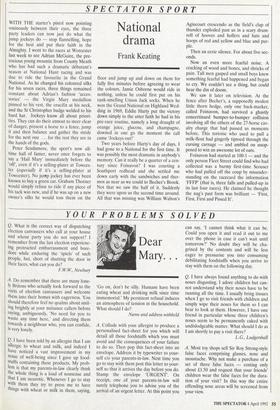SPECTATOR SPORT
WITH THE starter's pistol now pointing ominously between their eyes, the three party leaders can now just do what the jump jockeys do — stop flannelling, hope for the best and put their faith in the Almighty. I went to the races at Worcester last week to see Adrian McGuire, the pre- cocious young mountie from County Meath who has had such a dramatic de butanes season at National Hunt racing and was due to ride the favourite in the Grand National. As he changed his coloured silks for his seven races, three things remained constant about Adrian's fashion 'acces- sories' — the Virgin Mary medallion pinned to his vest, the crucifix at his neck, and the St Christopher badge welded to his hard hat. Jockeys know all about priori- ties. They can do their utmost to steer clear of danger, present a horse to a fence, jump it and then balance and gather the stride for the next one ... for the rest they are in the hands of the gods.
Peter Scudamore, the sport's now all- time hall of famer, never once forgets to say a 'Hail Mary' immediately before the `off, even if it's a selling-plater at Towces- ter (especially if it's a selling-plater at Towcester). No jump jockey has ever been known to buy a green car. Graham Thorner would simply refuse to ride if any piece of his tack was new, and if he was up on a new owner's silks he would toss them on the
National drama
Frank Keating
floor and jump up and down on them for fully five minutes before agreeing to wear the colours. Jamie Osborne would ride in nothing, unless he could first put on his rank-smelling Union Jack socks. When he won the Grand National on Highland Wed- ding in 1969, Eddie Harty put the victory down simply to the utter faith he had in his pre-race routine, namely a long draught of orange juice, glucose, and champagne, downed in one go the moment the call came 'Jockeys out!'
Two years before Harty's day of days, I had gone to a National for the first time. It was possibly the most dramatic in anybody's memory. Can it really be a quarter of a cen- tury since Foinavon? I was courting a Southport redhead and she settled me down early with the sandwiches and ther- mos as near as we could to Becher's Brook. Not that we saw the half of it. Suddenly they were upon us the second time around. All that was missing was William Walton's Agincourt crescendo as the field's clap of thunder exploded past us in a scary drum- roll of hooves and hollers and hats and hoops of red and yellow and blue and pur- ple.
Then an eerie silence. For about five sec- onds.
Now an even more fearful noise. A cracking of wood and bones, and shrieks, of pain. Tall men gasped and small boys knew something fearful had happened and began to cry. We couldn't see a thing, but could hear the din of doom.
We saw it later on television. At the fence after Becher's, a supposedly modest little thorn hedge, only one back-marker, called Foinavon, had survived a ghastly concertinaed bumper-to-bumper collision involving all the others of the 27-horse cav- alry charge that had passed us moments before. This tortoise who used to pull a milk-float had gingerly tiptoed through the cursing carnage — and ambled on unop- posed to win an awesome lot of oats.
Foinavon had started at 100-1 — and the only person Fleet Street could find who had collected was a barmy first-time Scouser who had pulled off the coup by misunder- standing on the racecard the information `FFFP' (that is, three falls and pulled-up in its last four races). He claimed he thought the nag's past form was brilliant — `First, First, First and Pissed It'.


























































 Previous page
Previous page